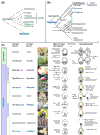Evolutionary origins of the endosperm in flowering plants
- PMID: 12225592
- PMCID: PMC139410
- DOI: 10.1186/gb-2002-3-9-reviews1026
Evolutionary origins of the endosperm in flowering plants
Abstract
The evolutionary origin of double fertilization and the resultant endosperm tissue in flowering plants remains a puzzle, despite over a century of research. The recent resurgence of approaches to evolutionary developmental biology combining comparative biology with phylogenetics provides new understanding of endosperm origins.
Figures

References
-
- Williams JH, Friedman WE. Identification of diploid endosperm in an early angiosperm lineage. Nature. 2002;415:522–526. - PubMed
-
- Friedman WE. Developmental and evolutionary hypotheses for the origin of double fertilization and endosperm. CR Acad Sci III. 2001;324:559–567. - PubMed
-
- Maheshwari P. An introduction to the embryology of angiosperms. 15. New Delhi: McGraw-Hill; 1995.
-
- Grossniklaus U, Schneitz K. The molecular and genetic basis of ovule and megagametophyte development. Semin Cell Dev Biol. 1998;9:227–38. - PubMed
Publication types
MeSH terms
LinkOut - more resources
Full Text Sources

